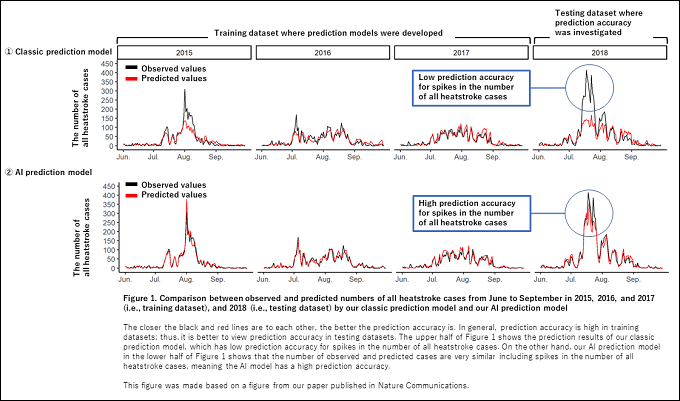Osaka, Japan – A team of scientists led by the National Cerebral and Cardiovascular Center Research Institute, Kansai University, and the National Institute for Environmental Studies were able to predict the incidence of heatstroke in Japanese cities using only publicly available information, such as demographics, weather forecasts, and time of year. Using a hybrid machine learning method that combined the best performing generalized additive model (GAM) and extreme gradient boosting decision tree (XGBoost), they were able to achieve a high level of accuracy. The model can be used by public health officials to help plan for the risk of heatstroke cases, hospitalizations, and deaths.
As average temperatures rise, so too does the chance of experiencing extremely hot days. Among the main hazards of high temperature and humidity is heatstroke, which can lead to central nervous system damage or even death. While some previous studies used weather information to develop prediction models for heat-related illnesses, they did not consider the level of severity.
Now, a team of scientists, including Soshiro Ogata and Kunihiro Nishimura from the National Cerebral and Cardiovascular Center Research Institute, Taira Ozaki and Keiichi Kitazume from Kansai University, and Shin Yamazaki and Yoshiki Yamagata from the National Institute for Environmental Studies used machine learning methods to predict the total number of heatstroke cases, hospital admissions, and deaths over a 12-hour period in each of 16 Japanese cities. They employed a hybrid model that combined the GAM curve-fitting and XGBoost decision tree methods trained on historical data.
“Our AI prediction model, which can also predict spikes in the incidence of heatstroke, is based on easily obtained weather and demographic data, so it can be widely applied,” first author Soshiro Ogata explains. The XGBoost method is a way to combine many weak predictions into a strong one. Here, the output of many decision trees—a kind of simple flow chart—are grouped to make one highly accurate forecast. The other method, GAM, uses smooth spline functions to fit nonlinear data, such as the occurrence of heatstroke over the course of the year.
“We anticipate that city-specific hybrid machine learning models, such as the one introduced by this project, will play a larger role in public health administration in the future,” corresponding author Kunihiro Nishimura says. The researchers also found that high temperature, small change in maximum temperature between consecutive hot days, high solar radiation, and having a large population of people aged 65 years and older were associated with larger risk.
###
The research is published in Nature Communications as “Heatstroke predictions by machine learning, weather information, and an all-population registry for 12-hour heatstroke alerts” (DOI: 10.1038/s41467-021-24823-0).
Research Grant
This research was supported by the Environment Research and Technology Development Fund (JPMEERF20191005) of the Environmental Restoration and Conservation Agency of Japan. This research was also supported by the Intramural Research Fund of Cardiovascular Diseases of the National Cerebral and Cardiovascular Center (30-6-15).
Contacts
Soshiro Ogata PhD, MHS
Senior Research
Department of Preventive Medicine and Epidemiology,
National Cerebral and Cardiovascular Center
6-1 Kishibeshin-machi, Suita, Osaka 564-8565, JAPAN
- What's New
- What's New 2025
- What's New 2024
- What's New 2023
- What's New 2022
- What's New 2021
- What's New 2020
- What's New 2019
- What's New 2018
- What's New 2017
- What's New 2016
- What's New 2015
- What's New 2014
- What's New 2013
- What's New 2012
- What's New 2011
- What's New 2010
- What's New 2009
- What's New 2008
- What's New 2007
- What's New 2006
- What's New 2005
- What's New 2004
- What's New 2003
- What's New 2002
- Event Information
- Visit NIES
